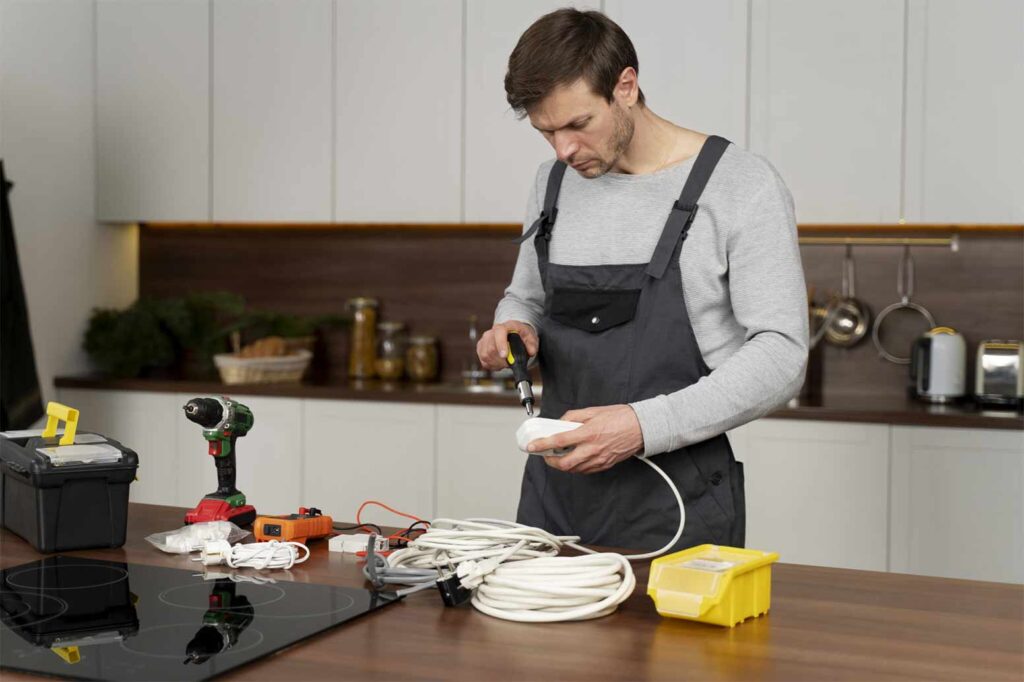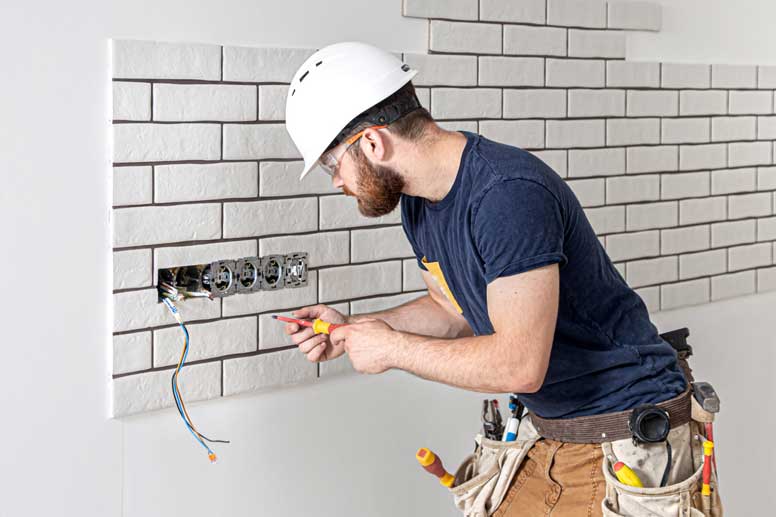How To Start An Electrical Business? Step-by-Step Guide

Starting an electrical business can be a great way to make a good living while providing a valuable service to your community. It’s definitely something to be excited about!
Of course, like any business, it’s important to do your homework and make sure you’re prepared.
This means understanding the rules and regulations and having a solid plan in place. But don’t worry, we’re here to help!
This guide will walk you through the essential steps of how to start and setting up your own electrical contracting business, from getting the right skills to finding potential customers.
Let’s get started!
Steps to Start your Electrical Business
1. Get training and a state license
Learning the ropes
Most places require you to complete a formal apprenticeship program.
These programs usually last about four to five years and combine classroom learning with hands-on experience working alongside a licensed electrician.
It’s like learning by doing! Some vocational schools and community colleges also offer electrical technology programs that can be a great starting point.
Testing your knowledge
Once you’ve completed your training, you’ll need to take a licensing exam.
These tests make sure you understand electrical codes (like the National Electrical Code, or NEC) and electrical theory, as well as how to apply that knowledge in real-world situations.
It’s like a final exam for your training!
Types of Licenses:
Journeyman electrician
This is the most common type of license. As a journeyman, you’ll work under the supervision of a master electrician.
Master electrician
With a master electrician license, you can work on your own, supervise journeymen electricians, and often obtain permits for electrical work. It’s like being the team leader!
Electrical contractor
If you want to own your own electrical business and contract work out to others, you’ll need an electrical contractor license.
RELATED ARTICLE: How To Price Residential Electrical Work?

2. Secure funding
Small business loans
One common option is pursuing small business loans from traditional banks and credit unions.
These institutions offer various loan programs specifically designed for electrical business owners like you, providing funds for essential startup costs such as equipment, vehicles, and initial marketing efforts.
Line of credit
Another helpful financial tool is a line of credit.
Think of this as a financial safety net. It grants you access to a pre-approved amount of money that you can draw upon as needed, repay, and then borrow again.
This flexibility is particularly beneficial for managing cash flow fluctuations and handling those unforeseen expenses that sometimes pop up.
Personal savings
Utilizing personal savings can be a really strategic move, especially if you’ve been planning for this venture for a while.
Using your own funds minimizes or even eliminates interest payments and allows you to retain full ownership of your business.
Plus, it shows a strong personal commitment, which can be attractive to potential lenders or investors down the road.
Investors (angel investors/venture capitalists)
For businesses aiming for rapid growth or larger-scale operations, seeking investment from angel investors or venture capitalists can be a viable option.
These investors can provide substantial capital injections, but it’s important to understand that this typically involves giving up a portion of ownership in your company in exchange for their investment.
SBA loans
Finally, exploring SBA loans can also be beneficial.
The Small Business Administration (SBA) doesn’t actually lend money directly; instead, they provide guarantees on loans made by participating lenders.
This guarantee reduces the risk for those lenders, making it easier for small businesses to qualify for financing, often with more favorable terms than traditional loans.
3. Create your business plan
A solid business plan is like a roadmap for your business. It not only helps you secure funding but also keeps you on track as you grow. Here are some key components to include:
Executive Summary
This is a brief overview of your entire business plan, highlighting the key points. Think of it as an “elevator pitch” that summarizes your business concept, goals, and financial projections. It’s usually written last but placed at the beginning of the document.
Company Description
This section provides detailed information about your business, including its legal structure (self-employed individual, LLC, etc.), mission statement, and the services you’ll offer. It’s where you explain what makes your business unique.
Market Analysis
Here, you’ll research and analyze your target market, including demographics, customer needs, and market trends. You’ll also identify your main competitors and assess their strengths and weaknesses. This demonstrates that you understand your industry and have a viable market for your services.
Organization and Management
This section outlines the structure of your company, including the roles and responsibilities of key personnel. If you have a team, you’ll introduce them here and highlight their relevant experience.
Service or Product Line
Here, you’ll describe in detail the electrical services you plan to offer. This could include:
- Residential wiring.
- Repairing electrical panels and circuit breakers.
- Repairing ceiling fans.
- Commercial installations.
- Maintenance of electrical components.
- Maintenance of older homes.
- Lighting fixtures.
- Solar panel installation.
- Smart home technology integration.
Sales and Marketing Strategy
This section details how you plan to attract and retain your customer base. It should include your marketing channels (online advertising, social media, networking, etc.), pricing strategy, and sales process.
Financial Projections
This is a crucial part of your business plan, especially if you’re seeking funding. It includes financial statements such as income statements, cash flow projections, and balance sheets. These projections demonstrate the financial health of your business.
Appendix
This section includes supporting documents such as licenses, permits, resumes of key personnel, and any other relevant information.
4. Get registration, business license, and insurance
Business registration
Register your business name and legal structure (self-employed individual, LLC, corporation) with the relevant state and local authorities. This process typically involves filing paperwork and paying fees.
Business licenses and permits
In addition to registering your business, you’ll also need to obtain any necessary business licenses and permits required by your city, county, and state.
The specific licenses and permits required can vary depending on your location and the nature of your business.
You can usually find out which licenses and permits you need by contacting your local government office or chamber of commerce.
Business Insurance
Having adequate insurance coverage is essential to protect your electric company from financial losses arising from various unforeseen circumstances. Here are some essential types of insurance to consider:
1. General liability insurance
This insurance covers bodily injury or property damage caused by your business operations to third parties.
2. Professional liability insurance
This insurance protects you from claims of negligence or mistakes made while performing electrical jobs for your clients.
3. Workers' compensation insurance
If you have employees, you’re legally required to carry workers’ compensation insurance. This insurance covers medical expenses and lost wages for employees who are injured on the job.
4. Commercial auto insurance
If you’ll be using vehicles for business purposes, such as traveling to client locations or transporting equipment, you’ll need commercial auto insurance. This insurance provides coverage for accidents involving your business vehicles.

5. Set up business accounting
Separate business bank account
When starting an electrical business, opening a dedicated business bank account is essential for keeping your personal and business finances distinct.
This separation simplifies bookkeeping, makes tax preparation easier, and provides a clear picture of your business’s financial health.
It also helps establish your business as a separate legal entity, which can be important for liability purposes.
Accounting software
Utilizing accounting software can significantly streamline your financial management.
These tools help you track income and expenses, generate invoices, manage payments, and create financial reports.
There are various accounting software options available, ranging from basic to more advanced, so you can choose one that fits your business needs and budget.
Bookkeeping and tax preparation
Managing your finances effectively requires consistent bookkeeping and accurate tax preparation. If you’re not comfortable handling these tasks yourself, consider hiring a bookkeeper or accountant.
They can help you maintain accurate financial records, ensure compliance with tax regulations, and provide valuable financial insights to help you make informed business decisions.
6. Purchase electrical tools and supplies
Hand tools
A good set of hand tools is the foundation of any electrician’s toolkit.
This includes essential items like various types of screwdrivers (flathead, Phillips, etc.), pliers (linesman’s, needle-nose, etc.), wire strippers, measuring tapes, levels, and more.
Choosing durable, high-quality hand tools will ensure they withstand regular use and last for years.
Power tools
Power tools significantly increase efficiency and make certain tasks much easier.
Essential power tools for electricians include drills (corded and cordless), saws (reciprocating saws, circular saws), wire cutters/crimpers, and various other specialized tools depending on the type of work you’ll be doing.
Again, investing in reputable brands known for their quality and reliability is a wise choice.
Testing equipment
Accurate testing is critical for ensuring the safety and functionality of electrical systems.
Essential testing equipment includes multimeters (for measuring voltage, current, and resistance), voltage testers (for quickly checking for live circuits), circuit testers, and other specialized testing devices depending on the complexity of the electrical systems you’ll be working on.
Calibration and proper maintenance of this equipment are essential for accurate readings.
Safety gear
Safety is non-negotiable in electrical work. Investing in high-quality safety gear is not just a good idea; it’s essential for protecting yourself and your employees.
Essential safety gear includes safety glasses, gloves (insulated and general purpose), hard hats, arc flash suits (for protection against arc flash hazards), and other personal protective equipment (PPE) as needed for specific tasks.
7. Learn how to price your electrical services
Material costs
Material pricing is a fundamental part. Carefully calculate the total cost of all materials required for each specific job.
This includes everything from electrical wiring and conduit to electrical outlets, switches, fixtures, installation costs, and any other necessary additional costs.
Be sure to factor in potential price fluctuations and consider adding a small buffer for unexpected material needs.
Labor costs
Determine your hourly labor rate (or the rates for your employees) and accurately estimate the time required (labor hours) to complete each job.
This involves considering the complexity of the task, the number of electricians needed, and any potential delays.
Accurate time estimates are crucial for ensuring your labor costs are covered. You can use our time-tracking software to help you!
Overhead expenses
Overhead expenses are the ongoing costs of running your business, regardless of the specific jobs you’re working on.
These include expenses like insurance premiums, rent for office or storage space, utilities (electricity, water, internet), marketing and advertising costs, vehicle maintenance, and administrative expenses.
It’s essential to factor these costs into your pricing to ensure they are covered.
Profit margin
After calculating the cost of materials, labor costs, and overhead expenses, you need to add a reasonable profit margin.
This is the percentage of revenue that remains after all expenses are paid.
Your profit margin should be sufficient to not only cover your personal income but also allow for reinvestment in your business, such as purchasing new equipment, training employees, or expanding your services.

Try our Profit Margin calculator
Do you need help calculating your Gross and Net Profit Margin? Try our Profit Margin Calculator for free.
RELATED ARTICLE: Gross Profit vs. Net Profit: Formula, Analysis & Examples

8. Build an estimate template with Invoice Fly
Using our Invoice Maker tool can significantly streamline your estimating and invoicing processes. This tool allow you to:
- Create professional estimates and invoices.
- Track job costs and profitability.
- Manage customer information.
- Generate reports.
9. Get your first customers
Networking
Connect with potential clients and partners by attending industry events, joining local business groups, and networking with other businesses, contractors (like general contractors, builders, and plumbers), and real estate agents. These connections can lead to valuable referrals.
Online marketing
A strong online presence is essential. Create a professional website showcasing your services and contact info. Use social media (Facebook, Instagram, LinkedIn) to connect with potential clients and build brand awareness. Online advertising (like Google Ads) can also reach targeted audiences.
Referrals
Word-of-mouth marketing is powerful. Encourage satisfied customers to refer your services. Offer referral incentives like discounts. Positive reviews are also valuable.
10. Hire electrical contractors
When you grow your business, you might find yourself needing to hire more qualified electricians to handle the increased workload.
When that time comes, it’s really important to make sure anyone you hire has the proper licenses and insurance—it’s a key part of running a responsible and safe business, and it protects everyone involved.
This also helps maintain the high standards of professionalism that you’ve worked so hard to establish.
The wrap-up
Getting into a small electrical business takes dedication, know-how, and a strong commitment to safety—it’s a field where precision and care are paramount. But with the right approach, it can be a fantastic career.
If you carefully following these steps, stay up-to-date on industry best practices, and consistently provide excellent service that exceeds customer expectations, you’ll be well on your way to a successful and rewarding career in electrical contracting.
Ready to Get Started?
Download Invoice Fly today!

Sarah Shaar is a SEO Content Writer born in Lebanon, and studied at the Lebanese American University.
With a background in journalism and a Master's in Digital Marketing, Sarah thrives in adapting to various copywriting disciplines.
Her passion lies in crafting creative and compelling content that speaks directly to her audiences.



